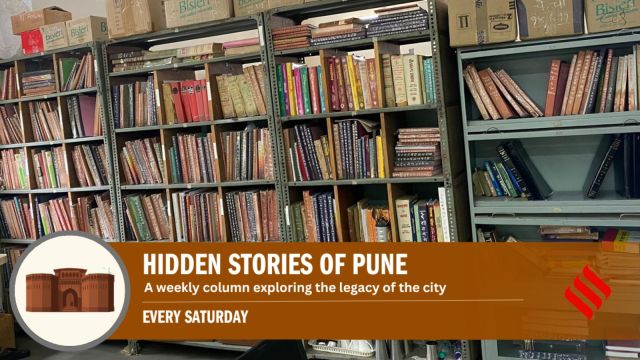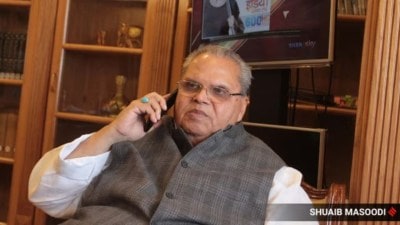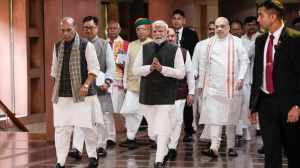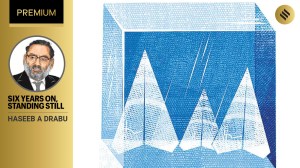Click here to join Express Pune WhatsApp channel and get a curated list of our stories
Hidden Stories: In Pune, a decades-long quest to preserve Prakrit continues
A thousand years ago, Prakrit languages were widely spoken across India. Today, a group of scholars in Pune is working on a Prakrit-English dictionary to document the language and its heritage.
 The library of manuscripts and references used for the Prakrit dictionary.
The library of manuscripts and references used for the Prakrit dictionary.In Pune, a city famous as the ‘Oxford of the East’, a silent-yet-consistent academic project has been taking shape for more than three decades. It is the Prakrit-English Dictionary Project being carried out by the Bhandarkar Oriental Research Institute (BORI) in collaboration with the Sanmati Teerth Trust, an organisation which is associated with Jainology and Prakrit language research, among others.
The aim is to preserve and document the linguistic and philosophical heritage of Prakrit languages. Already, it has rekindled interest in Middle Indo-Aryan languages and Jain literature among scholars. The project has completed 10 volumes, containing over 70,000 Prakrit words, and covering the letters from ‘a’ till ‘ch’.
Between 500 BC and 500 AD, a group of Middle Indo-Aryan languages were being spoken that were referred to as the Prakrits. According to the University of Oxford, “the name Prakrit (prākṛta) means ‘derived’, a name contrasting with Sanskrit (saṃskṛta) ‘complete, perfected’, reflecting the fact that the Prakrit languages were considered historically secondary to, and less prestigious than, Sanskrit”.
Among the Prakrit languages is Ardhamāgadhı̄, from the Magadha and the Mauryan empires and the language in which the earliest Jain texts were scripted, as Mahavira, the founder of Jainism, was born in Magadha. Māhārāṣṭrı̄, Śaurasenī, Māgadhī, and Avantī, widely used in literature, are Prakrit languages, as is Gāndhārī, “a far North-Western Indo-Aryan language once used extensively as a language of Buddhist literature in Central Asia”.
“A thousand years ago, Prakrit languages were widely spoken across India, while Sanskrit remained a formal and literary language. Not every language directly descended from Sanskrit; rather, languages evolved regionally, adapting to their own cultural and linguistic preferences. Modern Indo-Aryan languages evolved from various Prakrits and Apabhramsa dialects. For instance, Maharashtri Prakrit evolved into Marathi and Konkani, while Magadhi Prakrit influenced languages like Bengali, Assamese, and Odia,” says Dr Nalini Joshi, an eminent Prakrit and Sanskrit scholar who is the general editor of the dictionary.
The dictionary is the brainchild of the late Navalmal Kundanmal Firodia, a philanthropist and freedom fighter whose contributions include inventing the auto-rickshaw and pioneering the building of tempos as light commercial vehicles. Though the study of Prakrits began in Europe in the early 19th century, and later advanced in India through scholars and sadhus in the 20th century, Firodia was convinced of a need for greater scholarship.
While some dictionaries focused on individual Prakrits, an inclusive lexicon covering all Prakrit languages and literary forms was not available. The lack of an extensive Prakrit-English dictionary posed a challenge to scholars around the world to study Jain texts and the philosophical, metaphysical, and spiritual ideas they contain.
“Firodia roped in late Professor R N Dandekar, Honorary Secretary, BORI, to collaborate with the Sanmati Teerth, a trust he specially founded and funded for this purpose,” says Joshi.
In 1986, work began to create a Prakrit-English dictionary that would cover seven prominent Prakrit languages – Ardhamagadhi, Jain Maharashtri, Jain Shauraseni, Maharashtri, Shauraseni, Magadhi, and Apabhramsha.
The original team included the late Professor A M Ghatge, a renowned Sanskrit and Prakrit scholar, as the general editor of this dictionary. Dr R P Poddar took over as the second general editor.
Today, Joshi works with eight scholars, two of whom have also been bestowed with doctorates in the Prakrit language and Jainology. Originally, the project was housed at BORI and has now shifted to the Firodia Hostel.
“Over the course of three-and-a-half decades, we have compiled more than 70,000 words across 10 volumes, with citations from over 600 Prakrit texts, including Jain canons, mythological works, and scientific treatises that have been curated to provide a deeper understanding of each word’s usage and evolution. Ardhamagadhi is one of the most ancient languages, extensively used by Jain scholars. Along with Shauraseni and Maharashtri, it was used in Sanskrit dramas, including those written by Kalidasa,” says Joshi.
This dictionary is highly academic and not meant for beginners. It requires a strong background in Prakrit and Jainism to fully comprehend its depth. The new comprehensive dictionary is almost 20 times bigger than the popular Prakrit-Hindi Dictionary edited by Pandit Hargovind Das Trikam Chand Sheth.
“Now that Prakrit has been recognised as a classical language, there is growing interest in studying it, further reinforcing the importance of this dictionary. Despite its vast scope, it is not yet available online, making access somewhat limited. All the volumes of the dictionary are published by BORI. Our institution has taken significant steps to promote Prakrit studies by offering a special course in Prakrit and conducting regular examinations to encourage learning and research in this ancient language,” says Joshi.
The project is far from finished though. With financial backup and academic assistance from the Sanmati Teerth Trust and Shri Firodia Trust, the project continues with fresh optimism. The objective is still to build an extensive compilation of the Prakrit lexicon as researchers progress through the alphabetical entries, which will benefit future generations of scholars.
Click here to join Express Pune WhatsApp channel and get a curated list of our stories












